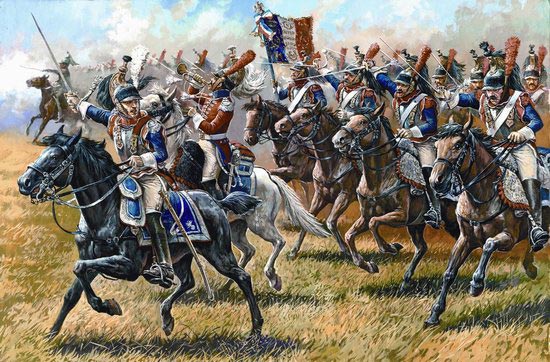I was reading about cavalry recently so some comments on cavalry use and armament may be of interest. The first topic will be the French cuirassiers and their weapon.
To discuss cavalry, and the French cuirassiers in particular it is necessary to understand a few basic facts. While not the most intelligent of animals, most horses are not so stupid that they can be made to charge into a wall, be the wall composed of bricks or men. An infantry unit in correct formation can withstand a cavalry charge so long as it maintains its integrity, nerve and discipline. If an infantry formation can be disrupted, either physically or psychologically, it may be shattered by a cavalry charge and either destroyed or routed. On these simple facts much of the course of human history has often pivoted.
The French cuirassiers were formed by Napoleon in 1801 and were intended for a specific purpose. The cuirassiers were intended to be a heavy cavalry reserve. Scouting, skirmishing, foraging and screening were the tasks of other cavalry. Cuirassiers were to be held back until the time and conditions were right for them to deliver a sledgehammer blow. During the Battle of Waterloo unsupported cavalry had to try and break British squares and the cuirassiers were deployed too early.
A cuirassier's reason for being was the charge. The approach of massed charging cuirassiers is reported to have had a mesmerising effect on an enemy. This was recognised by the cuirassiers themselves and a gorgon head is a common decorative motif on their equipment. The psychological effect of being charged might successfully delay the enemy's adoption of a formation that could resist it. Although issued with carbines the cuirassiers often did not bother carrying them or the associated paraphernalia necessary for loading them. Only 20% of cuirassiers felt inclined to carry pistols. The cuirassier's attack of choice was the arme blanche and the massed charge. During a charge there was not time to fire firearms. If the charge was successful the enemy would be broken and routing and the advantage would need to be pressed home with the weapon in hand.
Now that we have some context we can examine the type of sword used by the cuirassier. Cavalry charges were made with the point of the sword directed forward like a lance. The French were also notable advocates of the thrust being superior to the cut or slash. Marshal Saxe wanted cavalry to be equipped with a triangular-section blade that could not be used to cut. Not surprisingly the blade of a cuirassier's sword was straight, long and designed for thrusting. The first swords issued to the cuirassiers had a flat blade and a hatchet point. Readers familiar with British cavalry swords of this period will know that the 1796 Heavy Cavalry sabre of this time also originally had a hatchet point and was influenced by the Austrian 1775 cavalry sword. Unlike the British weapons the French swords had a tapered blade.
The cuirassier sword continued to evolve until it reached the form typified by the Model 1816 French Cuirassier's Sword. With minor variations swords similar to the 1816 seem to have armed the cuirassiers well into the 20th century. The 1816 had a 95cm long straight tapered blade with a spear point and double fullers for lightness and rigidity. Many earlier hatchet pointed swords were reground to have a spear point.
The French favoured the use of the sword point since it was more likely to inflict a fatal wound. This tactic was not without its potential drawbacks, however. If delivered from a speeding horse a bad strike could result in a sword wrenched from your hand and left behind buried in your target, leaving you unarmed on a battlefield. If attacking a routing enemy their backs might be protected by their packs and equipment. In his manual on the 1913 Saber George Patton advocated thrusting at the flank of a fleeing enemy but the successful timing and execution of this from a speeding horse might prove problematic. In one of his books Bernard Cornwell describes cavalry attacking fleeing infantry with a backhand cut at the face as they passed. While not necessarily fatal the physiological effects of such attacks on a fleeing unit should not be overlooked. It is also worth remembering that in the chaos of combat even the best trained man may swing rather the thrust and there will be times when a cut can be made in less time than it takes to position a point for a thrust.
I have never personally handled a cuirassier sword but it seems an intelligent design for heavy cavalry. It has a long reach and the taper of the blade probably helps handling. The blade appears well designed for thrusting but offering the option of cutting when needed. Some writers consider the French Model 1816 and the British 1908 as the best cavalry swords of all time.
If you have enjoyed this article or it has been helpful to you please feel free to show your appreciation. Thank you.
The Books






